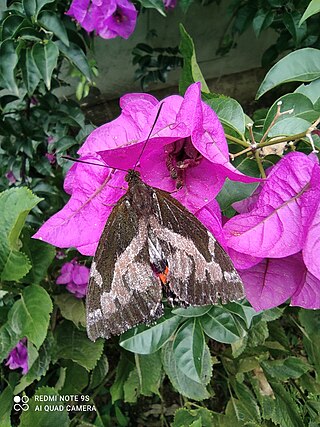
Castniidae, or castniid moths, is a small family of moths with fewer than 200 species: The majority are Neotropical with some in Australia and a few in south-east Asia. These are medium-sized to very large moths, usually with drab, cryptically marked forewings and brightly coloured hindwings. They have clubbed antennae and are day flying, and are often mistaken for butterflies. Indeed, some previous classification systems placed this family within the butterflies or skippers. The Neotropical species are commonly known as giant butterfly-moths, the Australian and Asian species as sun moths. The larvae are internal feeders, often on roots of epiphytes or on monocotyledons.

Telchin licus, the banana stem borer, is a moth of the Castniidae family. It is native to South America, where it is found from Colombia, Venezuela and the Guianas, throughout the Amazon basin in Brazil and Peru. It has also been recorded as an introduced species in Hawaii.
Hista is a genus of moths within the family Castniidae.

Xanthocastnia is a genus of moths within the family Castniidae containing only one species, Xanthocastnia evalthe, which is widespread in the Neotropical realm, ranging from southern Mexico to southern Brazil.

Synemon parthenoides, the orange-spotted sunmoth or link moth, is a moth in the Castniidae family. It is found in Australia, including Victoria, Western Australia and South Australia.
Synemon selene, the pale sun-moth, is a moth in the Castniidae family. It is found in Australia, including Victoria and South Australia.
Eupalamides guyanensis is a moth in the Castniidae family. It is widely distributed in northern South America, from Venezuela to Guyana, Colombia and Brazil (Pará).
Telchin syphax is a moth in the Castniidae family. It is widely distributed in the Amazon basin in South America.
Castnius pelasgus is a moth in the Castniidae family. It is found in Suriname, Peru and Amazonas.
Castnia invaria is a moth in the family Castniidae. It is found in South America.
Imara analibiae is a moth in the Castniidae family. It is found in the forest of the Estación Biológica La Selva, near Puerto Viejo, Sarapiquí, Heredia Province in Costa Rica. The habitat consists of a mosaic of mature lowland forest, secondary growth forest of various ages and abandoned pastures.

Imara pallasia is a moth in the Castniidae family. It is found in south-eastern Brazil. It is found along cloud forests.

Imara satrapes is a moth in the Castniidae family. It is found in Brazil, Paraguay and Uruguay.

Hista fabricii is a moth in the Castniidae family. It is found in Brazil. It mainly occurs in the southern and south-eastern parts of the country, in areas of the Atlantic Forest.

Geyeria decussata is a moth in the Castniidae family.
Corybantes pylades is a moth in the Castniidae family. It is found in Suriname, Brazil (Amazonas) and French Guiana.
Mirocastnia pyrrhopygoides is a moth in the Castniidae family. It is found in Ecuador, Peru and Colombia.
Mirocastnia canis is a moth in the Castniidae family. It is found in Peru.
Haemonides cronis is a moth in the Castniidae family. It is found in Mexico, Trinidad, Suriname, French Guiana, Brazil and Peru.
Lapaeumides zerynthia is a moth in the Castniidae family. It is found in Brazil, in the Neotropical realm. This species is likely found in lowland tropical forests, but future research is needed to confirm this.







